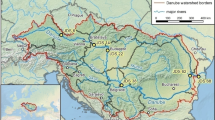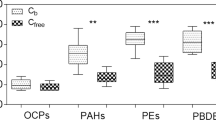Abstract
Few studies have been conducted examining the distribution of different-sized particles in sediment and its potential impact on bioavailability of sediment-associated contaminants. In the current study, three sediments composed of different particle sizes, i.e., fine (0–180 μm), combined (0–500 μm), and coarse (180–500 μm), were used to evaluate the bioaccumulation potential and toxicokinetic rates of four hydrophobic organic contaminants (HOCs) including two polychlorinated biphenyls (PCB-101 and PCB-118), a metabolite of an organochlorine insecticide (p,p′-DDE), and a polybrominated diphenyl ether (BDE-47) to the benthic oligochaete Lumbriculus variegatus. Two chemical approaches, Tenax extraction and matrix-solid phase microextraction (SPME), were also used to measure bioavailability of the sediment-associated HOCs. The uptake and elimination rates of HOCs by L. variegatus from coarse sediment were greater than those from fine sediment, although the biota–sediment accumulation factors (BSAFs) were not significantly different among sediments with different particle sizes. The freely dissolved HOC concentrations measured by matrix-SPME were greater in coarse sediment, however, no difference was found in uptake and desorption rates for the matrix-SPME and Tenax extraction measurements. Although BSAFs in L. variegatus were the same among sediments, kinetic rates of HOCs for organisms and freely dissolved HOC concentrations were lower in fine sediment, suggesting that sediment ingestion may also play a role in organism uptake, especially for HOCs in fine sediment.


Similar content being viewed by others
References
Amweg EL, Weston DP, You J, Lydy MJ (2006) Pyrethroid insecticides and sediment toxicity in urban creeks from California and Tennessee. Environ Sci Technol 40:1700–1706
Braekevelt E, Tittlemier SA, Tomy GT (2003) Direct measurement of octanol-water partition coefficients of some environmentally relevant brominated diphenyl ether congeners. Chemosphere 51:563–567
Conder JM, Lotufo GR, Bowen AT, Turner PK, Point TWL, Steevens JA (2004) Solid phase microextraction fibers for estimating the toxicity of nitroaromatic compounds. Aquatic Ecosystem Health and Management 7:387–397
Cornelissen G, Zuilen HV, Noort PCMV (1999) Particle size dependence of slow desorption of in situ PAHs from sediments. Chemosphere 38:2369–2380
Cornelissen G, Gustafsson O, Bucheli TD, Jonker MTO, Koelmans AA, Noort PCMV (2005) Extensive sorption of organic compounds to black carbon, coal, and kerogen in sediments and soils: mechanisms and consequences for distribution, bioaccumulation, and biodegradation. Environ Sci Technol 39:6881–6895
Eisma D (1993) Suspended matter in the aquatic environment. Springer-Verlag, Berlin, Germany
Handel E (1985) Rapid determination of total lipids in mosquitoes. Journal of the American Mosquito Control Association 1:302–304
Harkey GA, Lydy MJ, Kukkonen J, Landrum PF (1994) Feeding selectivity and assimilation of PAH and PCB in Diporeia spp. Environ Toxicol Chem 13:445–1455
Hawker DW, Connell DW (1988) Octanol-water partition coefficients of polychlorinated biphenyl congeners. Environ Sci Technol 22:382–387
Hendriks AJ, Linde AVD, Cornelissen G, Sijm DTHM (2001) The power of size 1. Rate constants and equilibrium ratios for accumulation of organic substances related to octanol-water partition ratio and species weight. Environ Toxicol Chem 20:1399–1420
Jonker MTO, Heijden SAVD, Kreitinger JP, Hawthorne SB (2007) Predicting PAH bioaccumulation and toxicity in earthworms exposed to manufactured gas plant soils with solid-phase microextraction. Environ Sci Technol 41:7472–7478
Kukkonen JVK, Mitra S, Landrum PF, Gossiaux DC, Gunnarsson J, Weston D (2005) The contrasting roles of sedimentary plant-derived carbon and black carbon on sediment-spiked hydrophobic organic contaminant bioavailability to Diporeia species and Lumbriculus variegatus. Environ Toxicol Chem 24:877–885
Laak TLT, Barendregt A, Hermens JLM (2007) Grinding and sieving soil affects the availability of organic contaminants: a kinetic analysis. Chemosphere 69:613–620
Leppanen MT, Kukkonen JVK (2000) Fate of sediment-associated pyrene and benzo[a]pyrene in the freshwater oligochaete Lumbriculus variegatus (Muller). Aquatic Toxicology 49:199–212
Mäenpää K, Leppänen MT, Kukkonen JVK (2009) Sublethal toxicity and biotransformation of pyrene in Lumbriculus variegatus (Oligochaeta). Sci Total Environ 407:2666–2672
Mayer P, Vaes WHJ, Wijnker F, Legierse KCHM, Kraaij RH, Tolls J et al (2000) Sensing dissolved sediment porewater concentrations of persistent and bioaccumulative pollutants using disposable solid-phase microextraction fibers. Environ Sci Technol 34:5177–5183
Millward RN, Fleeger JW, Reible DD, Keteles KA, Cunningham BP, Zhang L (2001) Pyrene bioaccumulation, effects of pyrene exposure on particle-size selection, and fecal pyrene content in the oligochaete Limnodrilus Hoffmeisteri (Tubifidae, Oligochaeta). Environ Toxicol Chem 20:1359–1366
Oleszczuk P (2009) The Tenax fraction of PAHs relates to effects in sewage sludges. Ecotoxicol Environ Saf 72:1320–1325
Rochne KJ, Shor LM, Young LY, Taghon GL, Kosson DS (2002) Distributed sequestration and release of PAHs in weathered sediment: the role of sediment structure and organic carbon properties. Environ Sci Technol 36:2636–2644
Sormunen A, Leppänen M, Kukkonen J (2008) Influence of sediment ingestion and exposure concentration on the bioavailable fraction of sediment-associated tetrachlorobiphenyl in oligochaetes. Environ Toxicol Chem 27:854–863
Styrishave B, Mortensen M, Krogh PH, Andersen O, Jensen J (2008) Solid-phase microextraction (SPME) as a tool to predict the bioavailability and toxicity of pyrene to the Springtail, Folsomia candida, under various soil conditions. Environ Sci Technol 42:1332–1336
Trimble TA, You J, Lydy MJ (2008) Bioavailability of PCBs from field-collected sediments: application of Tenax extraction and matrix-SPME techniques. Chemosphere 71:337–344
United States Environmental Protection Agency (2000) Methods for measuring the toxicity and bioaccumulation of sediment-associated contaminants with freshwater invertebrates. EPA 600/R-99/064, pp 63–71
van der Heijden SA, Jonker MTO (2009) PAH bioavailability in field sediments: comparing different methods for predicting in situ bioaccumulation. Environ Sci Technol 43:3757–3763
Verschueren K (1983) Handbook of environmental data on organic chemicals, 2nd edn. van Norstrand Reinhold, New York, NY
Yang Y, Hunter W, Tao S, Gan J (2008) Relationships between desorption intervals and availability of sediment-associated hydrophobic contaminants. Environ Sci Technol 42:8446–8451
You J, Landrum PF, Lydy MJ (2006) Comparison of chemical approaches for assessing bioavailability of sediment-associated contaminants. Environ Sci Technol 40:6348–6353
You J, Landrum PF, Trimble TA, Lydy MJ (2007a) Availability of polychlorinated biphenyls in field-contaminated sediment. Environ Toxicol Chem 26:1940–1948
You J, Pehkonen S, Landrum PF, Lydy MJ (2007b) Desorption of hydrophobic compounds from laboratory-spiked sediments measured by Tenax absorbent and matrix solid-phase microextraction. Environ Sci Technol 41:5672–5678
You J, Pehkonen S, Weston DP, Lydy MJ (2008) Chemical availability and sediment toxicity of pyrethroid insecticides to Hyalella azteca: application to field sediment with unexpected low toxicity. Environ Toxicol Chem 27:2124–2130
Acknowledgments
This work was partially supported by the Hundred Talents Program of the Chinese Academy of Sciences (kzcx2-yw-BR-05) and the National Natural Science Foundation of China (40971263). The authors thank Philipp Mayer for providing the SPME fibers. GIGCAS contribution Number 1252.
Author information
Authors and Affiliations
Corresponding author
Rights and permissions
About this article
Cite this article
Mehler, W.T., Li, H., Pang, J. et al. Bioavailability of Hydrophobic Organic Contaminants in Sediment with Different Particle-Size Distributions. Arch Environ Contam Toxicol 61, 74–82 (2011). https://doi.org/10.1007/s00244-010-9609-z
Received:
Accepted:
Published:
Issue Date:
DOI: https://doi.org/10.1007/s00244-010-9609-z




